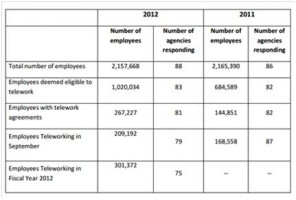Widgetized Section
Go to Admin » Appearance » Widgets » and move Gabfire Widget: Social into that MastheadOverlay zone
Telework Is Here To Stay
A note for our readers: the views reflected by the authors do not reflect the views of ASPA.
By Shami Dugal
Telecommuting is an arrangement by which a worker is eligible to work outside the office, often from home or remotely at a location. This location may be neither the office nor home, but affords the facilities that enable the individual to discharge their duties, agreed upon between the employer and worker.
Not every job can be done from home. Sales, sales support, knowledge workers including researchers, information technology professionals and accountants can largely perform their work through electronic connectivity to clients and colleagues and use collaborative tools that allow them to share information and dialogue pretty much across the world.
Many facets to this subject include productivity, cost, social isolation, flexible hours, weather, effect on health and so on. It is not for everyone and a great deal of discipline is needed to maintain a healthy work-life balance. However, studies show that this millennium has seen an increase in telecommuting, work sharing and alternative work methods and schedules.
According to figures gained from the Census Bureau’s annual American Community Survey, the typical telecommuter is a 49-year-old college graduate, of either sex, who earns about $58,000 annually and belongs to a company with more than 100 employees. However, let us not forget that even after the job is done at a normal 40 hour a week office on-site, many workers continue to work once they leave the workplace. Should that be considered telecommuting as well?
A recent news report that gained instant credibility stated that France had passed a law to stop workers from using email and other forms of work methods after 6 p.m. Given the North American view of the European short work weeks, long vacations and paternal leaves, it was easy to understand why this story stuck.
It really was not law but more so a negotiated agreement between employers and unions to limit work beyond 13 hours for workers who work daily, flexible hours and are not restricted to a 35-hour workweek. It is however easy to understand why it gained credibility given our views of the relaxed European work attitudes.
Private, not for profit and public sector organizations and studies all indicate that flexible work methods are on the rise, perhaps because they offer flexibility and freedom to workers. Employers can also benefit from it when there are traffic and weather problems and work can proceed unhampered by these conditions.
One organization and its website that offer a good deal of information such as telework charts, trends in the U.S. and abroad is Global Workplace Analytics. TeleCoa is a not for profit organization that takes a proactive approach in promoting telecommuting and has resources in the website to support its message. The public sector site, telework.gov, discusses the legislation, policies and statistics about telework in the federal government. For example, the chart that follows is from the Office of Personnel Management report titled “2013 Status of Telework in the Federal Government.” It shows that one in seven employees teleworked, to some degree, in 2012. As public organizations embrace this concept further, the ratio of private to public sector teleworkers is decreasing.
With the enactment of the Telework Act of 2010 (ACT), it requires “the head of each executive agency to establish and implement a policy under which employees shall be authorized to telework and for other purposes.” There is a public service website dedicated to this subject, www.telework.gov.
The Act, signed into law by President Obama on Dec. 9, 2010, promotes greater flexibility in the use of its workforce through telework. The highlights of the Act are that it applies to all federal executive agencies, provides a framework for agencies to leverage technology in maximizing the use of telework, recruit and retain talent and develop a written agreement between the agency and the teleworker.
The subject of telework, work-share and other such synonyms define a workplace that is here to stay. With the increasing availability of technology, the sophistication of appliances and the ubiquitous cloud and affordability practically across the world will only accelerate the concept of the mobile worker.
Telework is not for all professions, people and situations. But there is a sweet spot which has pretty broad dimensions.



Awais
April 20, 2014 at 3:56 pm
I totally agree with the writer.
Telework is the future. Even yahoo or no one else can stop it. as a human we all wants to have easy working.